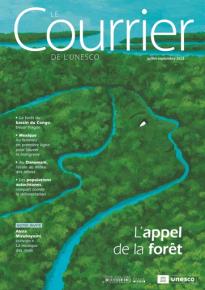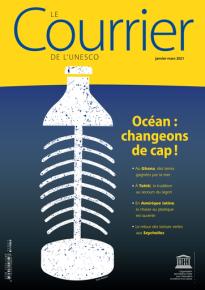出版物
前言


阿涅丝·巴尔东(Agnès Bardon)
联合国教科文组织
物种减少,自然栖息地萎缩,土壤和水遭到污染,生态系统受气候变化影响。尽管这些困扰地球的顽疾众所周知,且人们对此开展了长期监测记录,但迟迟不见有重大行动在全球范围内开展。
为尽快采取措施遏制这种现象,联合国宣布启动“联合国生态系统恢复十年”(2021—2030年)。而计划在2021年召开的几次重要会议也会把地球生物退化作为核心议题,其中包括国际自然保护联盟(IUCN)将于9月在法国马赛举办的世界自然保护大会。
另一个重要会议是将于10月在中国昆明召开的生物多样性公约缔约方大会第十五届会议。届时,《公约》的196个缔约方需制定2020年后全球生物多样性框架,并为国际社会确定到2050年如何改进生态系统保护工作的方针。
前所未有的恶化
情况万分紧急。2019年5月,生物多样性和生态系统服务政府间科学-政策平台(IPBES)在联合国教科文组织总部发布了具有里程碑意义的《生物多样性和生态系统服务全球评估报告》,其中的评估结论非常惊人。报告援引数据支持结论,提出了不容辩驳的证据,表明生态系统的健康状况正在以前所未有的速度恶化。生物多样性领域的政府间气候变化专门委员会专家指出,世界各地可能因人类活动而灭绝的动植物物种数量达到历史峰值。
人类已经极大地改变了至少四分之三的陆地环境和将近66%的海洋环境。在800万个地球物种当中,已有100万个物种面临灭绝风险。这意味着每8个动物或植物物种中就有一个可能在几年后彻底消失。
这显然是人类行为酿成的恶果。自然栖息地之所以会遭到破坏、支离破碎,其首要原因在于人类对自然环境的改造,特别是为了农业生产或城市发展而进行的改造。第二个原因则是人类开发自然资源以及污染土壤、水和空气。
在很长一段时间里,人们都认为是气候变化加重了以上种种风险。但现在,人们已明确认识到气候变化本身就是一项正在不断加剧的风险。气候变化导致某些物种丧失家园,朝南北两极、高山或海洋深处移徙。外来入侵物种是导致物种大规模灭绝的另一个因素,特别是在岛屿地区,这些物种对于岛屿本土动植物的破坏性极强。
与自然建立新的联系
由于生物多样性的丧失,各国实现联合国《2030年可持续发展议程》提出的多项目标的能力也随之受到削弱。简言之,生物多样性的丧失危及人类的未来。自然提供了人类生存所需的各种基本条件,用一个数字就可以概括这种依赖性——将近75%的粮食作物至少在一定程度上需要授粉。而海洋、土壤和森林吸收了人类排放的温室气体的60%。
在环境发生变化时,最贫困的群体却最先挺身而出。土著民族守护着地球上至少四分之一的土地和三分之一以上尚未被人类活动改变的地区,他们悉心呵护着自己的遗产,但即便是这些遗产,也因为蕴含丰富的自然资源而被人觊觎。
然而,这些土著社区传承的知识和做法理应得到更好的保护和推广,在联合国教科文组织地方和土著知识系统(LINKS)方案框架下,已有相应的行动逐步开展。因努伊特人关于北极浮冰的知识、泰国北部的克伦人实行的农业轮作制度、东非牧民的气象知识,无不证明这些让人类能够与自然和谐共处的知识技能至关重要。
相信物种的复原力
尽管出现了几个危险信号,但也传来了一些好消息。最新版国际自然保护联盟《濒危物种红色名录》显示,由于采取了有效的保护政策,一些物种正在逐渐恢复。其他物种在适应环境方面则表现出了惊人的复原力,它们出乎意料地适应了与原生环境截然不同的新环境,例如城市地区。
越来越多的区域被划定为保护区,这让人们能够保护生态系统。例如,联合国教科文组织世界遗产、生物圈保护区和地质公园网络的面积接近1000万平方千米,大致相当于中国的国土面积。
《生物多样性公约》更进一步。在为今后谈判提供出发点的一份最新“预稿”中,该公约建议196个缔约方承诺到2030年至少要保护地球面积的30%。这份文件还呼吁将化学和塑料污染至少减少50%,同时将部分重点地区的外来入侵物种传播速度至少减半。
这些目标志存高远,也符合当前的各项挑战。
拓展阅读:
《恢复海洋生物》,联合国教科文组织《信使》,2021年1-3月
《人类是一种地质作用力》 ,联合国教科文组织《信使》,2018年4-6月
《SIKU:现代科技与古老知识的融合》,联合国教科文组织《信使》,2019年1-3月
订阅联合国教科文组织《信使》,阅读发人深省的时事文章,数字版免费。
在社交网络上关注联合国教科文组织《信使》:微博、微信公众号“联合国教科文信使”、Twitter、Facebook、Instagram。
Agnès Bardon
UNESCO
The decline of species, the shrinking of natural areas, soil and water pollution, and the modification of ecosystems due to climate change. The ills plaguing the planet are well-known, and have been documented for a long time. And yet, significant actions on a global scale have been slow to be implemented.
The United Nations Decade on Ecosystem Restoration (2021-2030) has been announced to accelerate efforts to curb this phenomenon. The degradation of life on the planet will also be at the heart of several key meetings planned in 2021, including the World Conservation Congress organized by the International Congress for Conservation of Nature (IUCN) in Marseille, France, in September.
Another crucial meeting, the Conference of the Parties to the Convention on Biological Diversity, COP 15, will be held in Kunming, China, in October. The 196 parties to the Convention will have the task of defining a post-2020 Global Biodiversity Framework. They will set the course for the international community to improve the protection of ecosystems by 2050.
An unprecedented decline
The situation is urgent. In May 2019 at UNESCO, the Intergovernmental Science-Policy Platform on Biodiversity and Ecosystem Services (IPBES) presented an alarming assessment in its landmark Global Assessment Report on Biodiversity and Ecosystem Services. Using figures to back up its conclusions, it presented overwhelming evidence that the health of ecosystems is deteriorating at an unprecedented rate.
Human activities are now threatening more animal and plant species with extinction worldwide than ever before in history, the experts of this “IPCC (Intergovernmental Panel of Climate Change) of biodiversity” noted.
Humans have significantly modified no less than three quarters of the terrestrial environment and almost sixty-six per cent of the marine environment. And of the 8 million species listed on the planet, 1 million are already threatened with extinction. This means that one in eight animal or plant species is likely to disappear in the coming years.
Human actions are squarely to blame for this. The conversion of natural environments – particularly for agriculture or urban development – is the primary cause of the destruction and fragmentation of natural habitats. This is followed by the exploitation of natural resources and the pollution of soil, water, and air.
Long considered an aggravating factor, climate change is now identified as a growing risk. Among other effects, it causes the displacement of some species, as they move towards the poles, mountain tops, or the depths of the ocean. Invasive species are another factor behind the massive extinction – especially on islands, where they are particularly damaging for the native flora and fauna.
Forging new links with nature
The loss of biodiversity undermines our capacity to achieve many of the goals of the United Nations’ 2030 Agenda for Sustainable Development. In short, it puts our future at risk. Nature provides the services that are essential for human existence. A single figure sums up this dependence – almost seventy-five per cent of food crops depend, at least partly, on pollination. And the ocean, soils and forests absorb sixty per cent of greenhouse gases emitted by humans.
When it comes to environmental change, the poorest populations are on the front line. As the guardians of at least a quarter of the planet’s land, and over a third of the areas that have not yet been altered by human activities, indigenous peoples are watching over their heritage – but even that is increasingly coveted for its natural resources.
Yet, these indigenous communities are often the custodians of knowledge and practices that deserve to be better preserved and promoted – as is the case with the actions within the framework of UNESCO’s Local and Indigenous Knowledge Systems (LINKS) programme. The knowledge of the Inuit about Arctic ice floes, the shifting agriculture practised by the Karen people of northern Thailand, the meteorological knowledge of the herders in East Africa – all bear witness to the relevance of this know-how, which enables humans to live in harmony with nature.
Trusting the resilience of species
In spite of several red lights, there is some good news. An update of the International Union for Conservation of Nature’s IUCN Red List of Threatened Species shows that some species are recovering as a result of effective conservation policies. Other species are showing unexpected resilience by adapting to environments – such as urban areas – that are very different from their native habitats.
The designation of an increasing number of protected areas allows humans to preserve ecosystems, such as UNESCO's network of World Heritage Sites, Biosphere Reserves and Geoparks, which cover almost 10 million square kilometres – an area the size of China.
The Convention on Biological Diversity goes even further. In an updated “zero draft” that will serve as the starting point for future negotiations, it proposes that the 196 countries that are party to the convention commit to protecting at least thirty per cent of the planet by 2030. The document also calls for a reduction of at least fifty per cent in chemical and plastic pollution, and to halve the spread of invasive species in some priority sites.
The stated objectives are ambitious. They are in line with the challenges.










